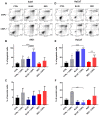Apoptotic mechanism activated by blue light and cisplatinum in cutaneous squamous cell carcinoma cells
- PMID: 33576463
- PMCID: PMC7891828
- DOI: 10.3892/ijmm.2021.4881
Apoptotic mechanism activated by blue light and cisplatinum in cutaneous squamous cell carcinoma cells
Abstract
New approaches are being studied for the treatment of skin cancer. It has been reported that light combined with cisplatinum may be effective against skin cancer. In the present study, the effects of specific light radiations and cisplatinum on A431 cutaneous squamous cell carcinoma (cSCC) and HaCaT non‑tumorigenic cell lines were investigated. Both cell lines were exposed to blue and red light sources for 3 days prior to cisplatinum treatment. Viability, apoptosis, cell cycle progression and apoptotic‑related protein expression levels were investigated. The present results highlighted that combined treatment with blue light and cisplatinum was more effective in reducing cell viability compared with single treatments. Specifically, an increase in the apoptotic rate was observed when the cells were treated with blue light and cisplatinum, as compared to treatment with blue light or cisplatinum alone. Combined treatment with blue light and cisplatinum also caused cell cycle arrest at the S phase. Treatment with cisplatinum following light exposure induced the expression of apoptotic proteins in the A431 and HaCaT cell lines, which tended to follow different apoptotic mechanisms. On the whole, these data indicate that blue light combined with cisplatinum may be a promising treatment for cSCC.
Keywords: skin cancer; blue light; cisplatinum; A431 cells; HaCaT cells; LED light; light therapy; cSCC; apoptosis; cytotoxicity.
Conflict of interest statement
The authors declare that they have no competing interests.
Figures







Similar articles
-
Induction of cisplatinum sensitivity without alteration in radiation sensitivity by fractionated radiation treatment of a human laryngeal squamous cell carcinoma cell line.Int J Radiat Oncol Biol Phys. 1995 Jun 15;32(3):681-5. doi: 10.1016/0360-3016(94)00634-W. Int J Radiat Oncol Biol Phys. 1995. PMID: 7790254
-
Aromadendrene oxide 2, induces apoptosis in skin epidermoid cancer cells through ROS mediated mitochondrial pathway.Life Sci. 2018 Mar 15;197:19-29. doi: 10.1016/j.lfs.2018.01.029. Epub 2018 Jan 31. Life Sci. 2018. PMID: 29407546
-
Apigenin induces apoptosis via tumor necrosis factor receptor- and Bcl-2-mediated pathway and enhances susceptibility of head and neck squamous cell carcinoma to 5-fluorouracil and cisplatin.Biochim Biophys Acta. 2012 Jul;1820(7):1081-91. doi: 10.1016/j.bbagen.2012.04.013. Epub 2012 Apr 24. Biochim Biophys Acta. 2012. PMID: 22554915
-
Effects of demethoxycurcumin on the viability and apoptosis of skin cancer cells.Mol Med Rep. 2017 Jul;16(1):539-546. doi: 10.3892/mmr.2017.6666. Epub 2017 May 31. Mol Med Rep. 2017. PMID: 28586041 Free PMC article.
-
miR-497 promotes the progression of cutaneous squamous cell carcinoma through FAM114A2.Eur Rev Med Pharmacol Sci. 2018 Nov;22(21):7348-7355. doi: 10.26355/eurrev_201811_16272. Eur Rev Med Pharmacol Sci. 2018. PMID: 30468480
Cited by
-
Progress of phototherapy for osteosarcoma and application prospect of blue light photobiomodulation therapy.Front Oncol. 2022 Oct 13;12:1022973. doi: 10.3389/fonc.2022.1022973. eCollection 2022. Front Oncol. 2022. PMID: 36313662 Free PMC article. Review.
-
Tumor-derived covalent organic framework nanozymes for targeted chemo-photothermal combination therapy.iScience. 2023 Jul 16;26(8):107348. doi: 10.1016/j.isci.2023.107348. eCollection 2023 Aug 18. iScience. 2023. PMID: 37554442 Free PMC article.
-
Is blue light exposure a cause of precocious puberty in male rats?Front Endocrinol (Lausanne). 2023 Jun 20;14:1190445. doi: 10.3389/fendo.2023.1190445. eCollection 2023. Front Endocrinol (Lausanne). 2023. PMID: 37409230 Free PMC article.
-
The effect of Fernblock® in preventing blue-light-induced oxidative stress and cellular damage in retinal pigment epithelial cells is associated with NRF2 induction.Photochem Photobiol Sci. 2024 Aug;23(8):1471-1484. doi: 10.1007/s43630-024-00606-6. Epub 2024 Jun 23. Photochem Photobiol Sci. 2024. PMID: 38909335
-
Keratinocytes Exposed to Blue or Red Light: Proteomic Characterization Showed Cytoplasmic Thioredoxin Reductase 1 and Aldo-Keto Reductase Family 1 Member C3 Triggered Expression.Int J Mol Sci. 2023 Nov 10;24(22):16189. doi: 10.3390/ijms242216189. Int J Mol Sci. 2023. PMID: 38003379 Free PMC article.
References
-
- Mateus C. Cutaneous squamous cell carcinoma. Rev Prat. 2014;64:45–52. - PubMed
MeSH terms
Substances
LinkOut - more resources
Full Text Sources
Other Literature Sources
Medical

